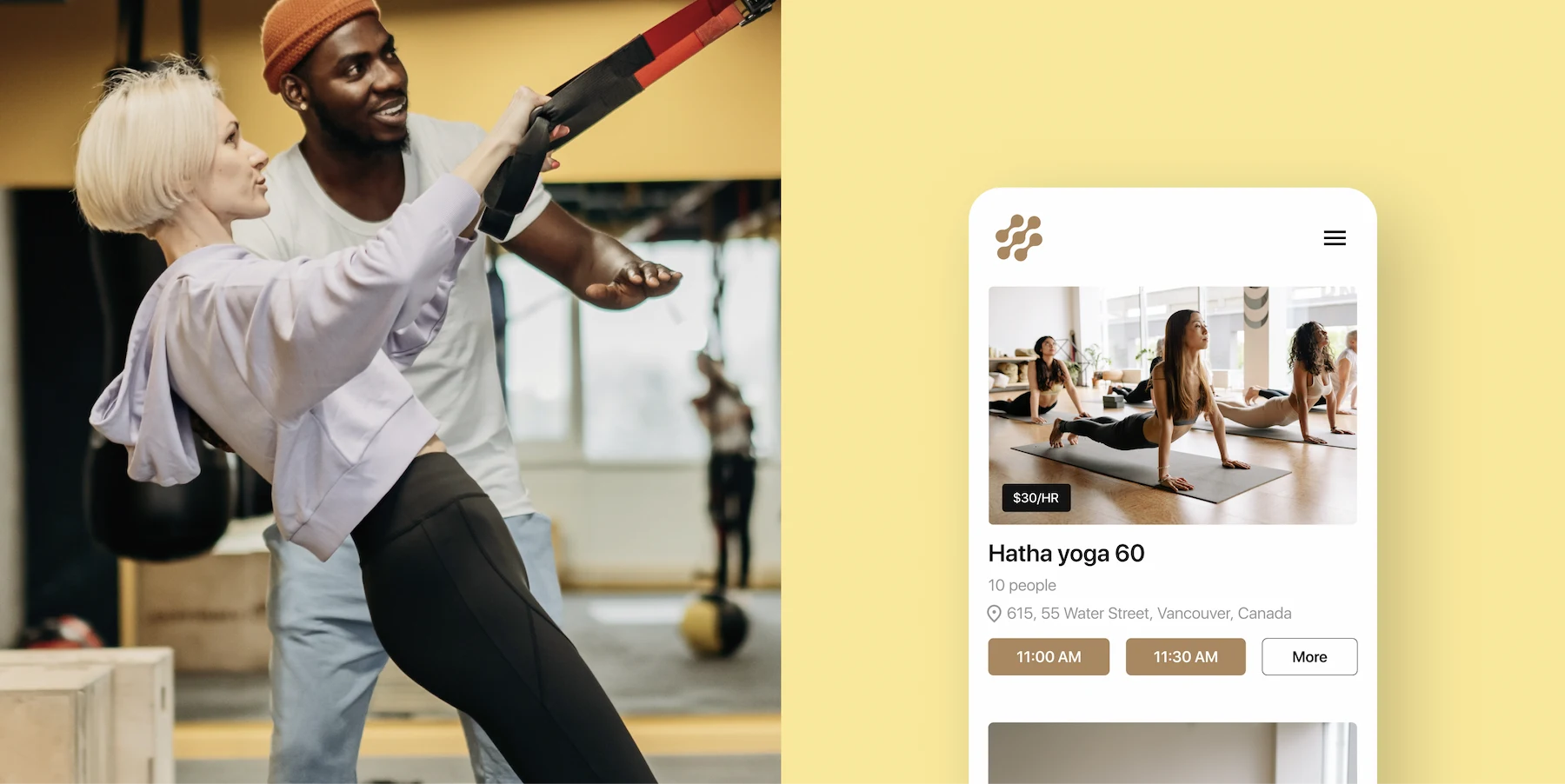
TL;DR
-
A micro-gym is a coworking-style fitness space that allows trainers and individuals to book private workout studios on demand.
-
It offers flexibility, privacy, and full client revenue control, making it ideal for independent fitness professionals.
-
Micro-gyms operate like coworking spaces, generating revenue through bookings, memberships, and add-on services.
If there’s one thing we’ve learned about niche coworking spaces, it’s this: where there is entrepreneurship, there is an opportunity for coworking.
One industry that is no stranger to entrepreneurship is the fitness industry. Personal trainers, yoga instructors, physical therapists — they can all work for themselves, and they all need a fitness-oriented space to work out of.
That’s where coworking fitness spaces and micro-gyms come in.
But what is the coworking and fitness trend? How do these two seemingly unrelated pieces fit together? And what can we expect from this trend over time?
What is a micro-gym?
A coworking fitness space, also known as a micro-gym, is a shared fitness facility primarily used by personal trainers and fitness instructors to train individuals or small groups of people.
Micro-gyms enable fitness professionals to operate their training business on their own terms while providing a more convenient, community-oriented, and flexible alternative to training for those looking to get in shape.
Because the concept is still so new, it’s worth noting that the term “micro-gym” is used to describe a variety of independently operated fitness facilities — from small garage studios to state-of-the-art facilities.
Learn how Optix can help you automate your micro-gym or shared fitness facility
Automate your micro-gym with Optix

Micro-gyms: where did they start?
One of the first micro-gyms to enter into the mainstream was Silofit, a Montreal-based fitness facility founded in 2018 that transformed small office spaces into private micro-gyms known as ‘silos.’
Individuals booked these silos by the hour and could even book a time with a trainer via the Silofit app. The concept exploded in popularity, and they grew to over 20 locations across the US and Canada, raising over $12 million dollars in the process.
Though they closed their doors in 2023 due to difficulties in the fitness industry post-COVID, Silofit paved the way for rethinking the traditional gym experience and making it easier for fitness professionals to start and run their own training business independently from commercial gyms.
Today, there are hundreds of micro-gyms around the world including FlexWerk, a revolutionary coworking and fitness studio in Indiana that is empowering fitness professionals to be their own boss.
“Our vision is to open, build, and drive an international franchise network of over 3,000 locations in the next ten years. This allows hundreds of thousands, if not millions, of fitness professionals, influencers, and anyone in the health and wellness space who has a client, to have the space, the technology, and the business support services to be their own boss.”Steve Pirt, CEO and Co-founder at FlexWerk

The micro-gym set-up
Micro-gyms vary widely depending on who the gym is targeting and where in the world they’re located. Here are a few examples of what could be considered a micro-gym:
- One large room with a variety of gym equipment or stations, often used to train one person or a small group of people
- Multiple rooms that serve different purposes such as a yoga room, a cardio room, and a strength room, all contained in one larger space
- Several all-in-one identical rooms that could be used concurrently by different personal trainers to train their clients
What a micro-gym is now and what it will be in the future will continue to evolve as the sector matures. Although they started as informal fitness facilities with basic equipment, we’ll see later on that they’ve evolved to be far more sophisticated.
Who are micro-gyms for?
Micro-gyms typically attract personal trainers, gym-goers, and content creators. Let’s take a look at each profile in more detail.
Personal trainers and fitness instructors
Personal trainers are oftentimes entrepreneurs. But in order to run their business, they need to invest in their own facility or work out of a large-scale commercial gym. The former option is a huge investment, while the latter limits growth and financial opportunities.
Micro-gyms offer trainers the freedom to run their own training business on their own terms, much like a freelancer renting out an art studio or a podcaster renting out a podcasting studio in a coworking space.
All they need to do is pay the flat fee to rent the space. In turn, they have access to all of the equipment they need, while keeping 100% of the profit they earn.
Gym-goers
Individual gym goers seek out micro-gyms because they’re looking for a more intimate, one-on-one fitness experience. They want to work out with the guidance of a personal trainer or fitness instructor in a small group setting, without having to go to a large, intimidating gym.
Fitness content creators
Micro-gyms are also an appealing option for fitness influencers and content creators. Fitness instructors who film videos for social media often need a professional and private space to create content.
What attracts them to micro-gyms is the opportunity to have a fully equipped space in a private setting where they can film without having to worry about disturbing others or violating gym privacy regulations.
A few notes to keep in mind about the audience of a micro-gym:
- Some micro-gym owners focus only on attracting personal trainers who then bring their own clients. These spaces are not typically open to the public for drop-ins.
- Other spaces may choose to employ personal trainers and market to gym goers, much like other boutique fitness studios.
- And other spaces may choose to market to personal trainers, gym goers, content creators, and whoever else needs an on-demand private space to work out.

The benefits of micro-gyms
The greatest benefits of small-scale gyms are increased privacy, cost-efficiency, and flexibility. People have a private space to work out of that is affordable and can be booked on-demand.
For fast-paced fitness entrepreneurs, there is nothing better than that.
- Increased privacy: small-scale fitness facilities offer more privacy than a traditional gym, which can help professionals better support their clients.
- Cost-efficient: while private gyms are typically more expensive than big-box gyms for gym-goers, they are a far more affordable option for those looking to start their own personal training business. They also do not typically take a cut of revenue from personal trainers, as the trainers are paying to use the space.
- Flexible memberships and access: micro-gyms typically work on a month-to-month or no-commitment schedule and can be used if and when needed. This is different from other gym memberships which can lock you in for one to two years.
Considering how well-equipped these spaces are, micro-gyms are a great alternative for those who want a professional-looking facility to train in without having to invest in creating their own.
What is the micro-gym business model?
Micro-gym owners typically make money through selling space and community memberships, just like the coworking business model.
Memberships can come in the form of monthly memberships offering a set number of hours of space booking a week or for a flat rate or hourly bookings that can be booked on-demand for a set period of time.
There are other ways the micro-gym owners make money including:
- Sell products by other brands through a digital marketplace
- Sell their own branded products
- Create a digital offering, like resources or a community
- Sell their own branded gym equipment.
- Add-on services or amenities like saunas and ice baths
Micro-gyms and coworking spaces
Micro-gyms have more in common with coworking spaces than just the business model. Both coworking spaces and micro-gyms:
- Are centered around community: a major reason why personal trainers and gym goers look for alternatives to big gyms is they are looking for a community feel.
- Empower entrepreneurs to start their own businesses: coworking spaces have long been giving freelancers and start-ups a place to begin their own businesses. Micro-gyms enable personal trainers to start their own businesses, too.
- Are beneficial for networking: having so many fitness professionals in one space creates an opportunity for individuals to learn from others in the industry.
- Offer amenities and perks for members: many coworking spaces offer amenities and perks to their members. Micro-gyms may offer these too, like discounts on partner brands and access to saunas or ice baths.
- May have a digital component: some micro-gyms choose to offer digital or online personal training. Coworking spaces often have digital communities as well, connecting their members outside of in-person time.
A micro-gym is another creative coworking niche to come out of the coworking and flex space movement. We expect to see this trend only continue to grow over time!

FlexWerk: changing the game for micro-gyms
Looking for an example of a micro-gym? Look no further than Optix client and changemaker, FlexWerk.
FlexWerk is a revolutionary micro-gym in Indiana, and the first coworking space specifically designed for fitness professionals. Founded by Steve Pirt, his mission is to empower the world’s fitness professionals to be their own boss.
For Steve, the traditional gym model is antiquated. Employees’ time is largely taken up by menial tasks, hospitality is low on the list of priorities, and canceling a gym membership requires meeting in person and signing a piece of paper.
At FlexWerk, members have access to fully customizable FlexSpaces, an easy reservation system, and hourly bookings with no long-term commitments making it the ideal space for new or seasoned fitness professionals to operate a successful business.
It’s a gym, but better.
Learn how Steve is using Optix to power his incredible community of fitness professionals.
“Our mission is to empower the world's fitness professionals to be their own boss. And in order to do that, we had to create what I call the world's first coworking spaces specifically designed for fitness professionals.”Steve Pirt, CEO and Co-founder at FlexWerk

Getting started with a micro-gym
As more and more people look to small, community spaces to satisfy their fitness needs, micro-gyms are in a fantastic position to capitalize on this demand.
If you’re looking to start a micro-gym, Steve Pirt shared all of his best tips in our interview with him that we recommend checking out. Here are a few more things you’ll want to keep in mind.
1. Determine who your target audience is, first
There are lots of different kinds of micro-gyms for lots of different kinds of people. Think about who your target audience is first before committing to opening a space.
The size of your space, the equipment you purchase, and what you choose to offer will all be heavily influenced by your target market.
Even once you do define that audience, always be open to change. One of Steve’s greatest pieces of advice is to embrace experimentation both in who you serve and what you offer.
“I have a good vision, but that doesn't mean I know it all, and I don't need to know it all. The way we grow successfully is by validating the customer's needs and solving a solution, plain and simple. Make your guesses, observe, and then take action.”Steve Pirt, CEO and Co-founder at FlexWerk
2. Consider adding a digital offering to your community
A physical space can only go so far. Consider adding a digital component to your community to provide more value to members and to generate more revenue. This could be a:
- Premium digital community and message board
- A digital library of fitness videos
These digital components have great margins and are a relatively low up-front investment.
3. Use technology to help you automate your micro-gym
The right combination of software and hardware can help you run your micro-gym autonomously while cutting down on overhead costs considerably.
Steve has deployed a number of strategic technology systems to help him create what he calls a “friction-free ecosystem” — a space where nearly everything can run autonomously. This is where coworking automation software like Optix comes in.
Optix offers flexible space management software for micro-gym owners and operators. With Optix, members can book workout equipment, pay invoices, and access the space all from their phones. On the backend, you can use Optix to automate invoice follow-ups and other manual recurring tasks, from onboarding to training.
To learn how Optix can help you automate your micro-gym, book a demo today!
Marketing Manager
Kelly Karn is the Marketing Manager at Optix coworking software. She's been covering the latest and greatest in the world of coworking for 4 years and is one of the leading voices in coworking content having written over 300 articles. You can find her work on Coworking Insights, Coworking Resources, Allwork.space, DeskMag, GCUC, and (of course) the Optix blog.
Frequently asked questions
A micro‑gym, sometimes known as coworking for fitness, is a shared fitness facility where personal trainers, instructors, influencers, and clients can use and book professional workout areas by the hour or month.
Micro-gyms primarily serve independent personal trainers, fitness enthusiasts, and content creators who seek private, cost-efficient, and flexible space without the commitment of traditional gyms.
Micro-gyms provide privacy, affordability, on-demand access, and entrepreneurial freedom. Trainers pay flat space fees and keep 100% of client earnings.
Micro-gym owners generate income through hourly or monthly space bookings, memberships, add-on services, digital offers, branded products, and retail sales.



